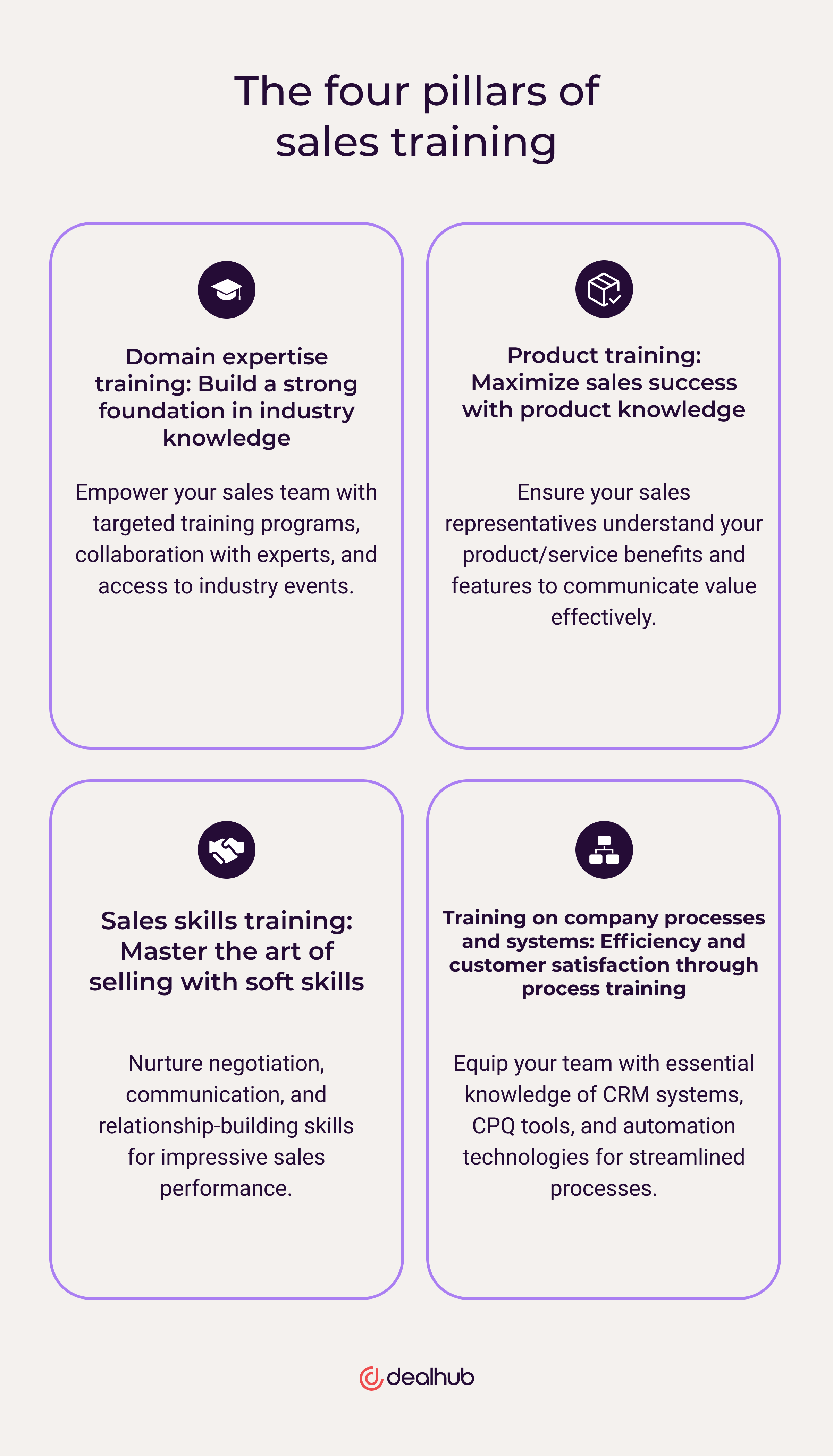Explore the process of engaging your team in continuous training and enhancing your internal infrastructure with us. In this article, we will introduce you to the concept of sales readiness guides, delve into the four pillars of sales training, and highlight critical KPIs that will not only boost sales performance but also prepare you for scaling your sales team effectively when the time is right.
The dynamic nature of sales
The dynamic nature of sales reflects the constantly evolving and fluid environment in which sales professionals operate. This dynamism arises from various factors, including shifting customer preferences, rapidly changing market trends, continuous technological advancements, fierce competition, and the increasing globalization of business.
Sales teams must navigate this ever-changing landscape by staying agile, embracing new technologies, and adopting customer-centric strategies to effectively meet the evolving needs of their target markets while remaining competitive and adaptable in their approaches.
Sales readiness guides training and development

A productive sales readiness plan acts like a compass that guides training and development efforts. Consider it a strategic framework designed to ensure that a sales team is well-prepared and equipped to perform in a dynamic and competitive business environment. Sales readiness plans encompass a range of elements, including knowledge, skills, tools, and processes, all aimed at enhancing the capabilities of sales professionals.
A sales readiness plan can address the evolving nature of sales and lay out strategies to ensure your team handles ongoing learning seamlessly. Having a sales readiness plan prepares companies for:
- Industry shifts. Markets, customer preferences, and product landscapes constantly evolve. A sales readiness plan allows organizations (and sales representatives) to stay agile and adapt to these changes.
- Continuous learning. A readiness plan emphasizes the need for ongoing education and skill development. This ensures that sales professionals are well-prepared during onboarding and equipped to evolve with the market’s demands over time.
- Competition. A consistently well-prepared team provides organizations with a significant competitive advantage. A sales readiness plan ensures that your team differentiates itself by being informed, skilled, and ready to address customer needs.
- Customer-centric sales. Sales readiness plans often include training on understanding customer needs and expectations. This customer-centric approach is vital for building strong relationships and offering solutions that align with the customer’s goals.
- Efficient onboarding. A sales readiness plan extends beyond initial training. It ensures that onboarding is a seamless process and that new hires quickly integrate into the team’s culture and processes, becoming productive contributors faster.
- Tool and technology integration. Sales processes are increasingly reliant on technology and tools. A readiness plan includes training on CRM systems, CPQ and billing tools, and other relevant technologies to enhance efficiency and productivity.
- Risk mitigation. Preparing for potential challenges, industry shifts, or changes in customer behavior helps mitigate risks. A sales readiness plan enables organizations to anticipate and address challenges proactively, reducing the impact of unforeseen circumstances.
An effective sales readiness strategy encompasses the essential knowledge, abilities, and procedures required for sales teams to thrive. This strategy guarantees that sales experts are consistently provided with up-to-date tools and knowledge, empowering them to adeptly maneuver through the continually changing business environment.
The 4 pillars of sales training

Your sales representatives don’t just need to understand your product or service. They must also be familiar with the industry and the systems they’ll be using daily so that every interaction with a customer is seamless and professional.
A robust approach to sales training involves four key pillars that, when integrated together, ensure your sales representatives have everything they need to address clients and land deals.
- Domain expertise training
Sales success begins with a deep understanding of the industry. Domain expertise is the foundation upon which effective selling is built.
Companies can foster industry-specific knowledge by:
- Providing targeted training programs
- Encouraging collaboration with experts
- Allowing access to information and content
- Immersing sales teams in industry events
- Investing in collaboration tools for efficient team communication
A salesperson equipped with domain expertise – and the tools they need to continuously expand their knowledge base – is better positioned to address customer needs.
- Product training
In-depth product knowledge is essential for successful selling. When sales representatives understand your product,service benefits and features, they can translate your company’s value to clients. While this may seem intuitive, 48% of salespeople admit to needing help communicating value.
Ongoing product training ensures that sales teams stay informed about new offerings, enabling them to showcase the value proposition to customers. When companies prioritize ongoing product training, they’re also investing in long-term success, as:
- Every dollar spent on training translates to $4.53 recouped: a 353% return on investment.
- Proper training lowers employee turnover by as much as 50%.
- The average sales of those who receive training are 46% higher (according to one Harvard study).
- Sales skills training
Sales is about more than just communicating product value. There’s an art to selling; investing in nurturing the soft skills needed to sell is just as important as keeping teams informed of new product features.
Continuous training in negotiation, communication, and relationship-building skills is paramount. The soft skills that translate into impressive sales numbers are often overlooked. You can change that by directly encouraging soft skills development by providing a framework for sales conversations. Approaches such as:
- BANT (Budget, Authority, Need, Timeline)
- MEDDIC (Metrics, Economic Buyer, Decision Criteria, Decision Process, Identify Pain, Champion)
empower sales teams to qualify leads appropriately and conduct meaningful conversations.
- Training on company processes and systems
Modern sales processes are intertwined with technology. Training on CRM systems, CPQ and billing tools, and other company-specific processes is essential for efficiency and customer satisfaction. These tools have the added benefit of having built-in automation features that can reduce the need for sales teams to spend time on redundant tasks.
Automation can help sales representatives manage their workload and leads by handling time-consuming administrative work (like sending emails or booking meetings). According to McKinsey, 70% noted their organizations are leveraging or piloting automation technologies in one (or more) departments or functions (up from 66% in 2020 and 57% in 2018).
Proper training on processes and systems will help sales teams better use their time. It can help them streamline processes and close deals faster. Take, for example, Contentsquare, a global leader in Digital Experience Analytics.
Due to its rapid growth and the need to revamp its existing processes, Contentsquare’s choice to adopt a CPQ (Configure, Price, and Quote) system was primarily driven by two key factors. Firstly, the company placed significant importance on scalability as it expanded and aimed to modernize its operations. Secondly, the team aimed to simplify intricate tasks like complex pricing structures, to enhance operational efficiency. As Contentsquare’s expansion continued and it attracted investments, the advantages of embracing an Agile CPQ solution became progressively more evident, motivating the company to make this strategic decision.
As a result, Contentsquare has achieved seamless revenue lifecycle management, effortless quote generation, user-friendly complex configurations, and ensured data integrity throughout all its business systems.
Measuring training effectiveness
Implementing ongoing training programs is not enough; evaluating their impact is equally crucial. Follow the progress of your training and measure its effectiveness by keeping an eye on key performance indicators (KPIs):
Conversion rates. This is the percentage of leads that convert to sales. Improved conversion rates indicate that the sales team is successfully applying the training.
Deal size. If the average monetary value of a closed deal rises after training initiatives are implemented, it indicates the team is positioning and selling higher-value solutions.
Sales cycle length. Effective training should lower the average time to close a deal from the initial contact. Shortened sales cycles suggest that the sales team is improving the process of moving prospects through the sales pipeline, possibly due to improved skills acquired through training.
Customer satisfaction and NPS (Net Promoter Score). Feedback from customers about their satisfaction with the sales process and the product/service can measure if the sales team is not only closing deals but also delivering a positive experience, reflecting the impact of soft skills training.
Win rate. This KPI measures the percentage of deals won compared to the number of opportunities. A higher win rate indicates that the sales team successfully applies the training to close deals.
Time to proficiency for new hires. This is the average time for new sales hires to become fully productive. A shorter time to proficiency indicates that onboarding and training programs effectively integrate new team members.
Overcoming challenges in training
Many organizations face common training obstacles, such as a lack of time, resistance to change, and a shortage of resources. However, embracing a culture shift to ongoing sales training has proven very good for business. After all, according to Gartner, effective coaching and training can unlock an 8% improvement in sales performance.
To overcome traditional challenges and unlock sales performance improvement, companies must prioritize training, integrate it into daily routines, and leverage technology to make learning accessible and convenient.
Building a culture of sales excellence
Sales leaders must champion a proactive approach to learning within their organizations. A culture where ongoing training is encouraged and valued will propel sales teams to new heights of success. To embrace change, you must prepare for it. Invest in your team’s growth, and you’ll enjoy ongoing sales success.





